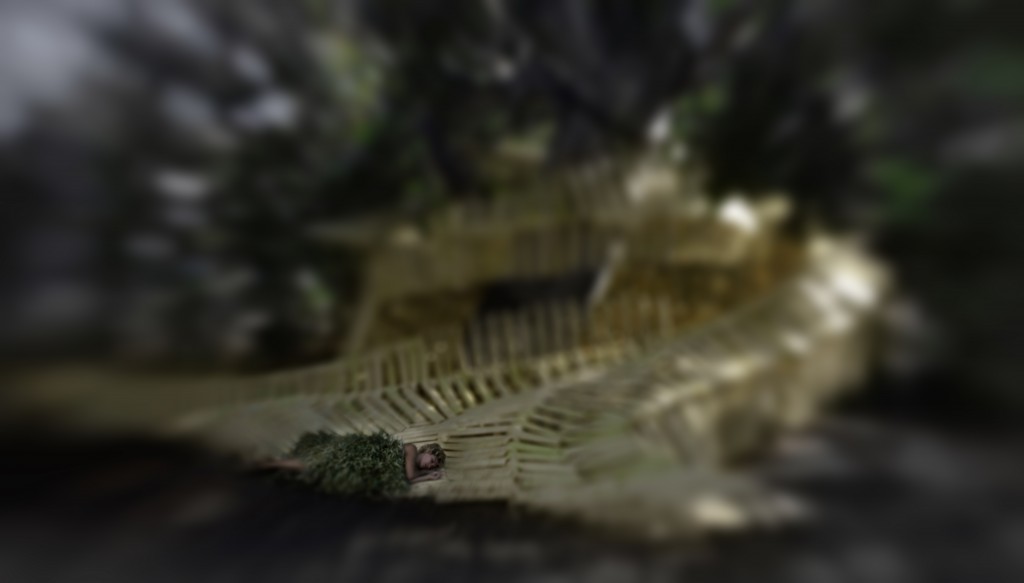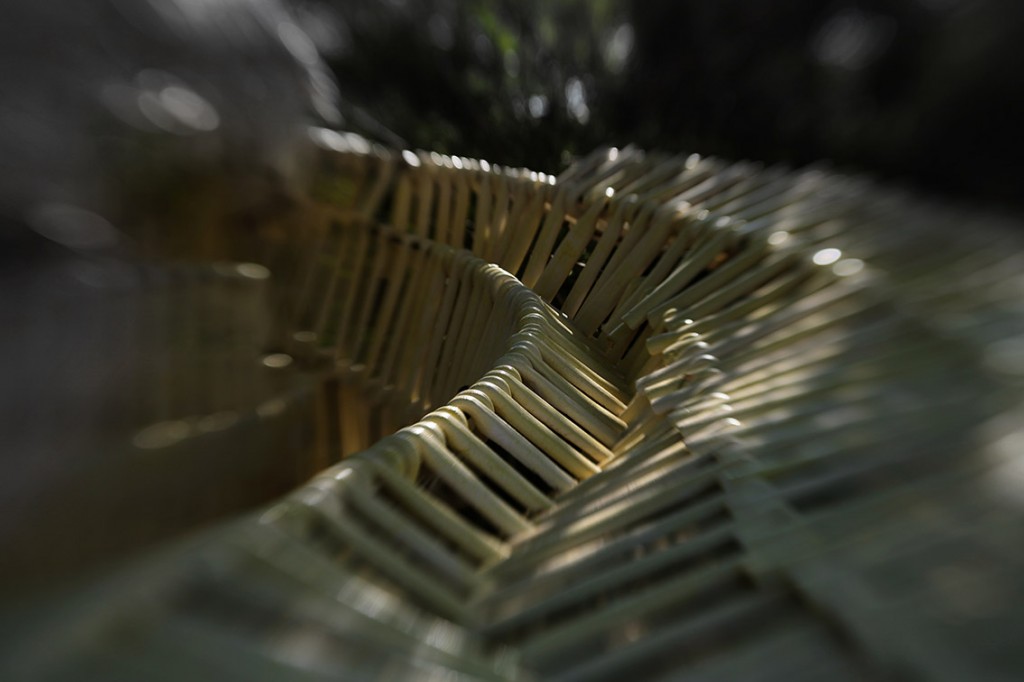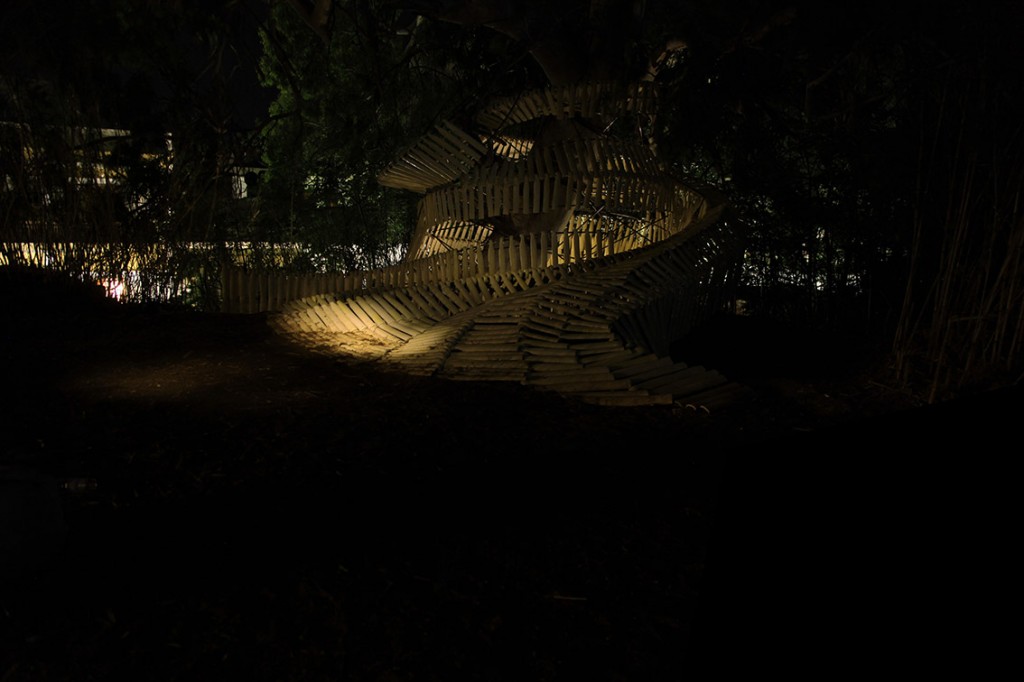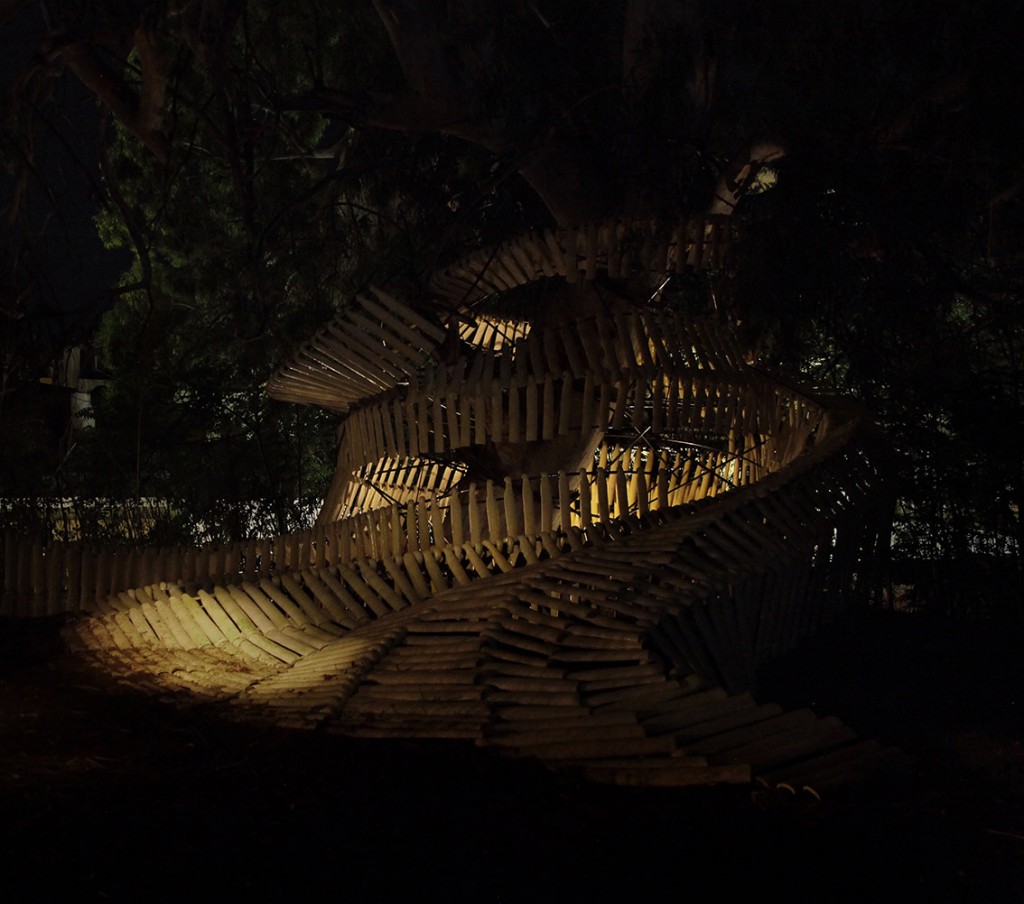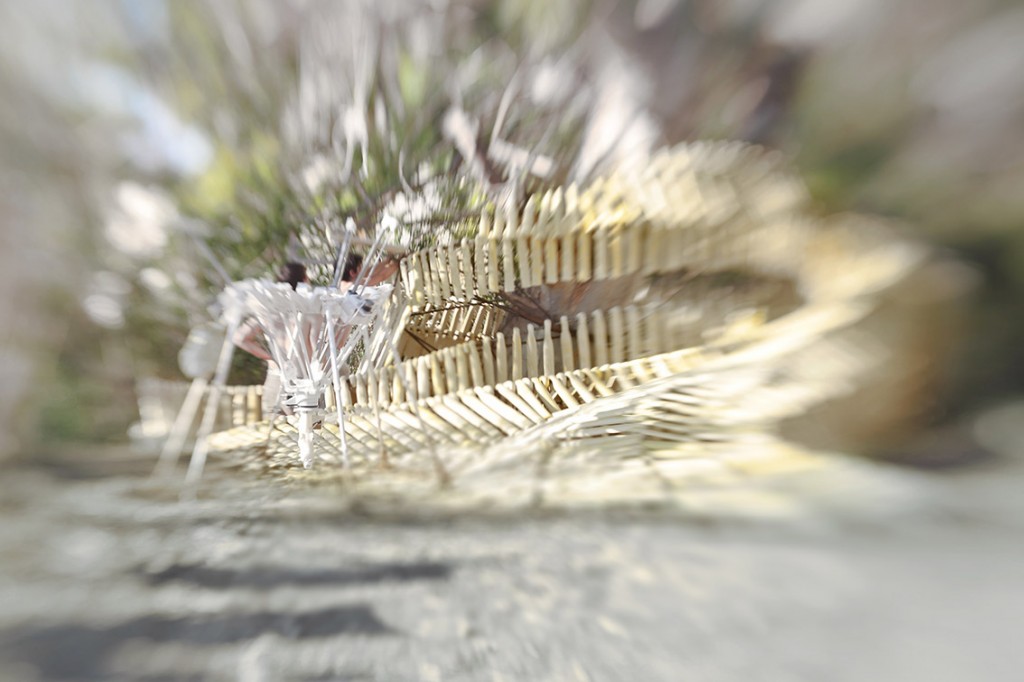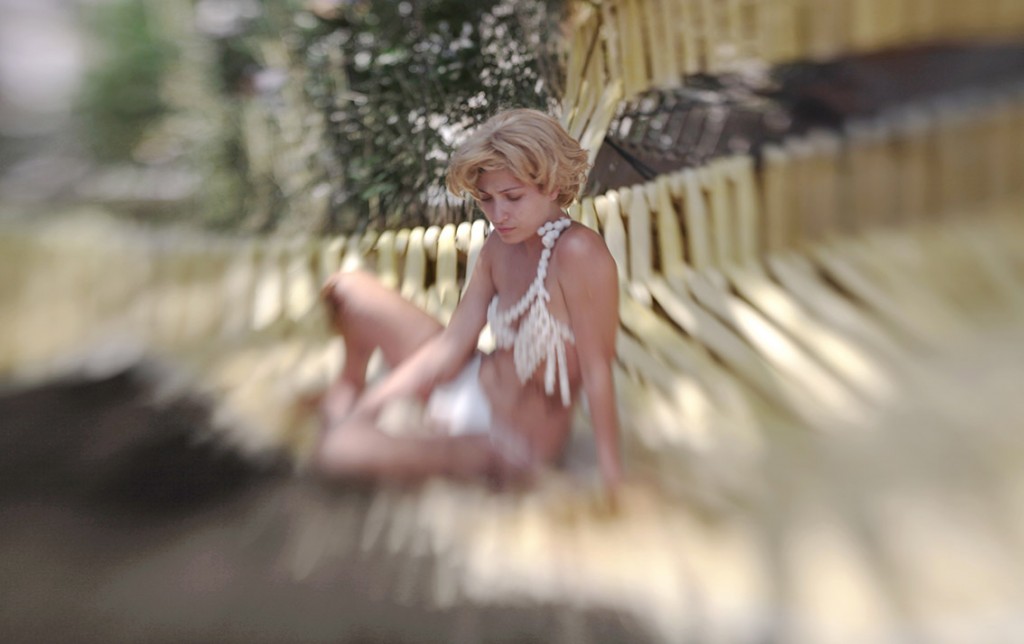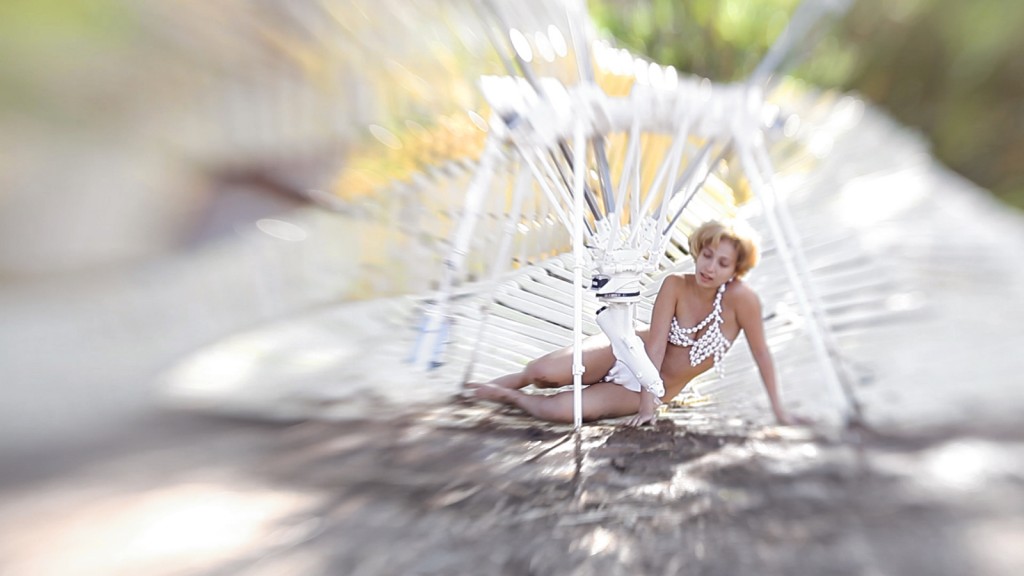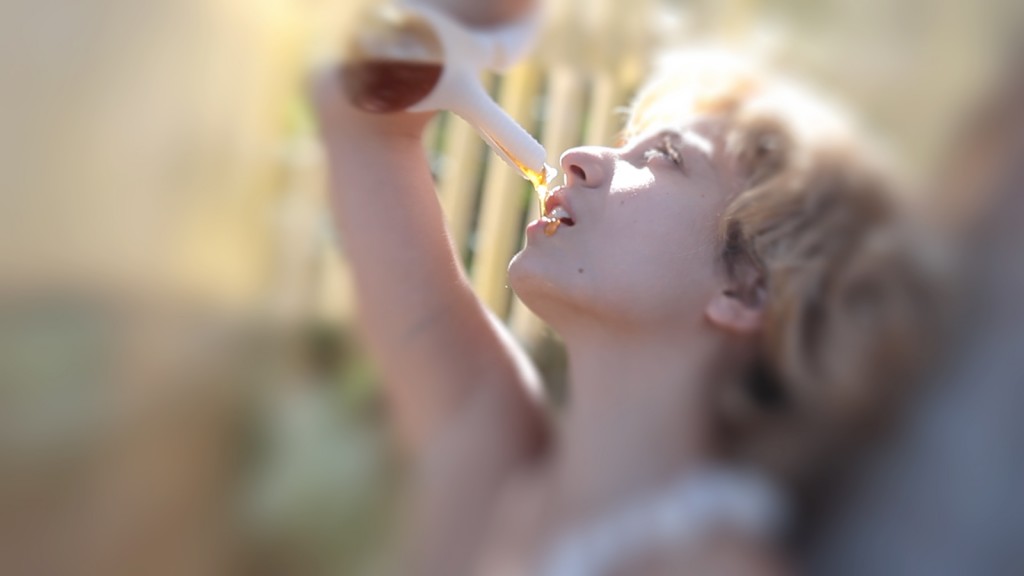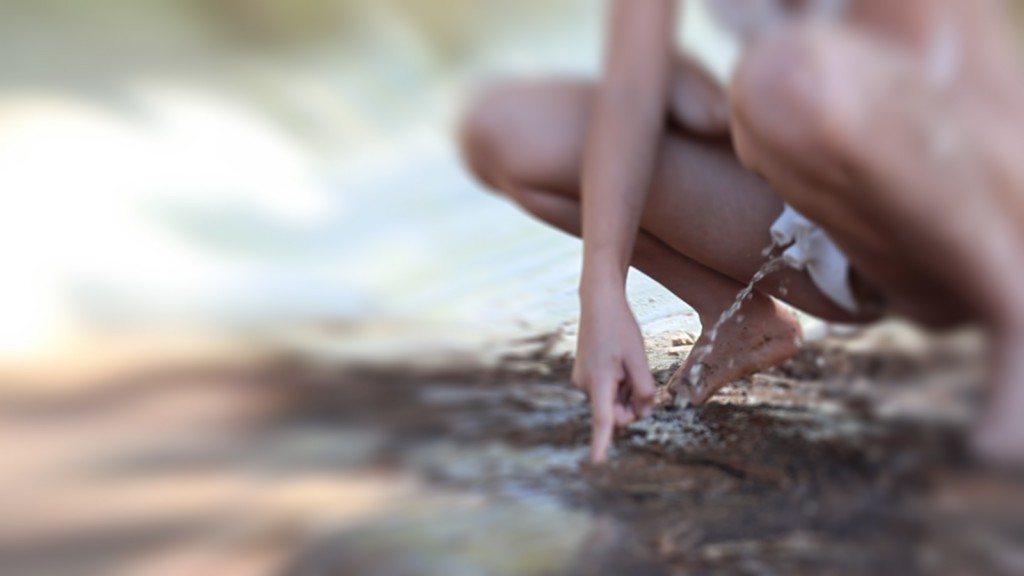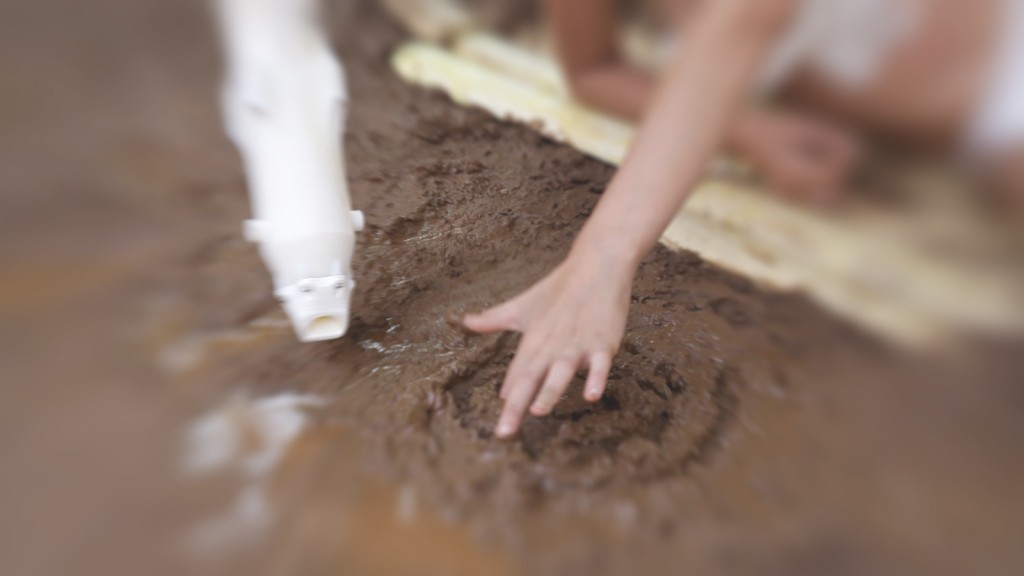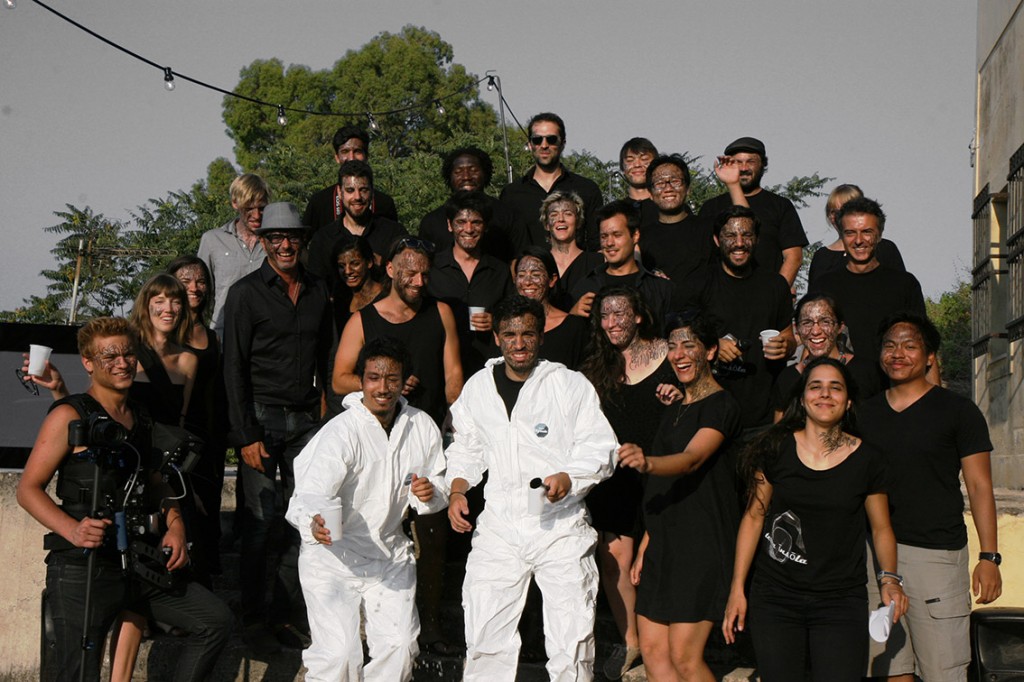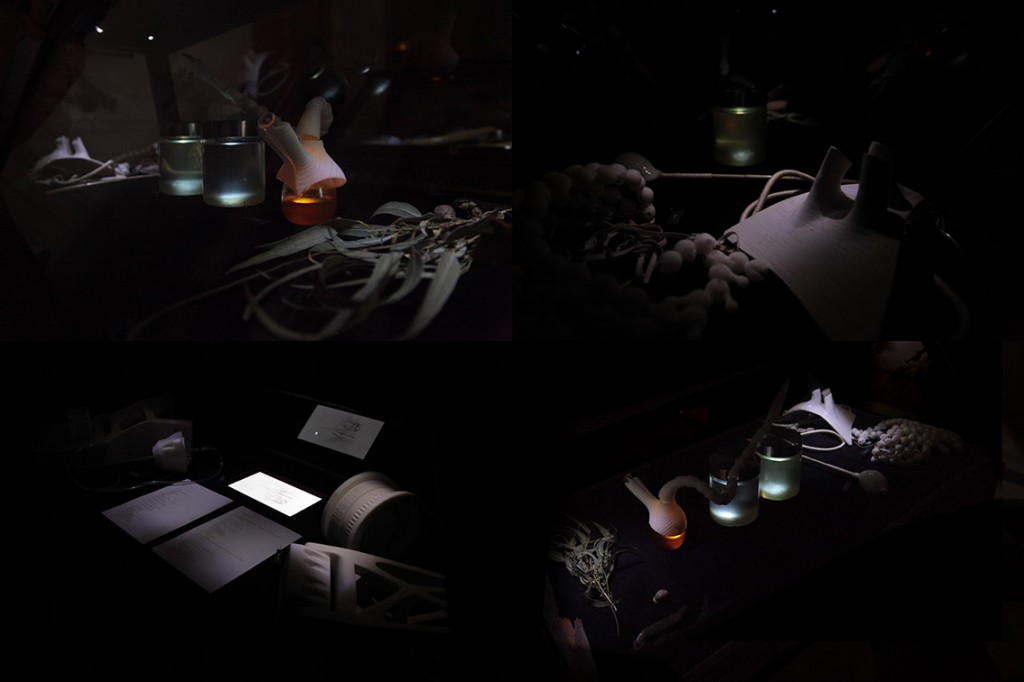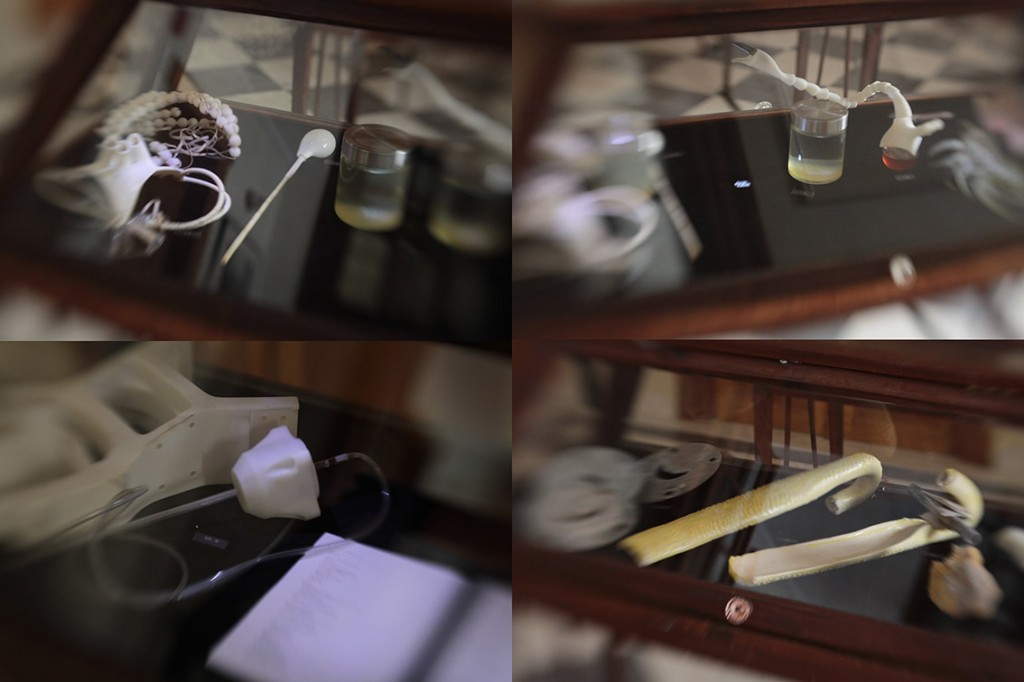Terra Insola is a collective enterprise of scientific storytellers, speculative archeologists, regenerative engineering, deviant-mythologists and dirty-physiologist exploring the mythic figure of Ariadne as an archetype of a modern feminist, living within a suspended time between two stages of her life, in the time between her relationships with Theseus to Dionysus, between the macho-man and the alcoholic.
She is bound by a daytime routine and her perpetual commitment to a machine, releasing herself from all constraints and achieving self-sufficiency. In desexualizing her innate nature she reaches a degree of serenity and ‘ataraxy’. She lives in an idyllic biotope without context or reference, extracting fluid sap from the eucalyptus tree that sustains her nourishment in an anthroposophic exchange, and mixes her physiological substances (such as urine) with the earth that surrounds her to secrete ceramic for the structure that shelters and interlaces her. The structure itself is a metaphor of an endlessness creation, an architectural process that emerges within an infinite loop. The myriad of spiraling mazes and glazed clay components that wrap her body and her mind are developed by and with a machine tamed and domesticated by Ariadne to extend her desires and construct her needs in a reflexive, affective and contingent agenda. La “Demoiselle”, the nickname she gave to her “productive” pet seems to engage an intertwined, co-dependent relationship that emerges from sympathy to empathy.
Ariadne is a woman divided by the pathology of multiple personality disorder, haunted by the echoes of her mythic past and her involuntary landing within the Schengen trap.
When she lands, the barrier of Schengen was already since a long time considered as a fortress. Nobody remember exactly when this fence became for European citizen their own jail… inversing the preliminary reason of its constitution, to protect them against the world… but appearing contradictorily as an historical illusion.
In this a political and ideological island, Ariadne appeared with two identities, the one who escapes from inside, embracing with her friendly “Demoiselle” a topological inversion, as an infinite fortressless animism, to protest emotionally against the contradiction, the absurdity of the situation, and the other trapped in a postindustrial location, crossing zombified human hostage of alienated Fordism tasks rhythmed by mute, dumb machinism.
Chania-Naxos becomes the location of Ariadne’s own schizophrenia simultaneously releasing and congealing herself from her state of limbo.
The Location of the event is an existing “fortress” in Chania, an abandoned Venetian walled zone of 15 meters high in the middle of the city, inaccessible… Ariadne takes refuge inside this no man’s land, ignored by the people living around… there, she could re-invent, as an utopia the routine of her freedom…but just in the middle of the European Union “Protectorate”.
Speculative Archeologists (Computation)
In the life of an archeologist there is transient sense of pride in the moment of recovery crumbling remnants of the past. The endless journey of digging in the mud can only be endured by this fleeting hope of conquering a bit of knowledge of what we might have been. This momentary joy is mixed, nevertheless, with anxiety and deep melancholy. There is a sense of emptiness to find a piece, a fragment of a whole object which is invisible. There is emptiness because the empire to which we have laid all hope is nothing but a powder of formless ruins and we are only left with fossils of a triumph that cannot be reassembled. Fragments of found knowledge are tropes of a lost empire, of something that might have once defined us and as such we pretend to stem from the illusion that this ancestry still delimits us. The fear of reassembly, the fear of projection marks the absence of one truth and it stems from another anguish, that of changing the arrow of time. In this locale, this distress is expressed through the practice of absolute preservation in the illusion that there is a truth in the past that cannot be transformed, regenerated or mixed with other time zones; it cannot participate in a process of experimentation, a process of imagining the possible fluid space between the found pieces. The pieces thus float, suspended between voids in a canvas of a forensic analysis. What is the crime though? The crime might be this void, our inability to cope with a stretched notion of time between the past and the future; it might be the unconscious denial of the ego to bridge a gap between the past and the present as a peculiar defensive reaction against the fear of the unknown, manifest by projecting the future not as an entirely new course of events but as an organic thread linked to past glory. Preservation might be a pathology projected in our unquestioned consent to abide to linear time, to a phantom of a truth that no longer applies to who we are.
Speculative archeologists venture to imagine the projection of past piece and the glue between them as they reflect on us today. They unearthed forms of the labyrinth and through generative form-finding processes, they forecast the glue of the prison that now envelops us. It is a tree, inside a spiral, inside an inaccessible plot of land, inside an island. The labyrinth allows them to project and experiment our sense of nested entrapment in multiple levels reinvigorated from found-symbols of ancient ruins and artifacts. The experimental archeologists used the eucalyptus tree as both an impetus and a constraint of their design, adaptively retrofitting the progress of their archeological dig to the ancient artifacts and future findings of the site.
The process of reinventing the space of the labyrinth is a process of resynchronization with contemporary scientific tools, using algorithmic functions of incremental adjustments stitching pieces of found knowledge and forms. Like Roland Barthes spoke of the Argo ship, as a carrying vessel whose pieces needed to be substituted piece by piece as the Argonauts were traveling, algorithmic functions are incremental rules, none of which are individually spectacular or unique. Rather, they overall produce, through a sum of small insignificant details, a spectacular topography of envelopment. Although our spiral assays to discover the glue of a given setting, the manner in which this shift is accomplished numerically, pixel by pixel reveals an infinite number of new possibilities, in the course of the morphological character being established. This is a complexity produced not by genius, inspiration, determination or evolution, but by a modest action of simple substitutions which cannot be caught up in any mystique of genuine creation.
Regenrative Engineers (Robotics)
Ariadne’s decoding of the labyrinth convicted Deadalus inside the omphalos [ομφαλός] he created. Such was his fate for reconstructing a physical vortex that would eat and digest all travelers. In effect, the famish Minotaur was only a decoy to the hunger of the labyrinth itself, the space of a black hole with such gravitational pull that subjects were bound to aimlessly drift, disintegrate and ingested by this spatial machine. In captivity, Daedalus relinquished his mental aptitude to generate ideas, unprecedented and unmixed with anything extant in the physical world -parthenogenesis [παρθενογένεσης]; he became an avid material collector, a dirty bricoleur that would lay his hands deeply in the soil, ravage pieces of the walls he once built with pride, scavenge fallen feathers of migrating birds and interrogate their newly formed relationships. His deliberate mental blockage was an operative self-containment, barricading reception of any perceptual input from the exterior world; he shut down environmentally in the vortex while experiencing a deep regression, drifting through the malicious walls he had designed. The territorial demarcation of obstruction-markers forced him to invent mechanisms and material organizations that would not have been probable outside the penalty of his own omphalos [ομφαλός]. Rather than generating ideas as a type of virgin birth, Daedalus was now driven by the desire for transforming and re-tooling existing physical resources, feathers and wax. The myth, outsourced as common knowledge, tells us that the failure of his son Icarus to fly above the sea and his dramatic fall and demise, indicates not only the failure of Daedalus’ endogenous [ενδογενής] machine, but most significantly the hubris to surpass human nature; a hubris which was symbolically penalized for not respecting the inherent limitations of human power. This precise hubris though, the will to create an impossible machine, made of soft pieces, fragments and fluids, even though it would most likely fail, is what makes Deadalus a regenerative engineer, a handler of humours contrived by the syndrome to produce a machine imbued the vitalism of a digestive stomach. Daedalus’ endogenous [ενδογενής] machine was not only an adhoc assemblage of fragmentary physical objects of its own locale, but was also in direct co-dependence with the extended biotope; it was a fragile being in synch with the ambient ether [αιθήρ] and so its malfunction was only proof of its vitalism.
On one end, Deadalus’ action is indicative of a fractured activity of artisanship, of craftsmen that work as a group in an organic co-dependency with the locale. As is known, guilds [συντεχνία], coalitions of workmen with a dissolved sense of agency, were lost in industrialization. The fordist machine tuned to the determination, efficiency and optimization of production replaced the worker’s anomaly in a series of repetitive binary tasks. What is production though now, in a world of DIY construction kits, home manufacturing personal 3D printers and a Wikihouse with open-source plans that can be personalized, improved and updated anywhere? Benjamin’s Work of Art in the Age of Mechanical Reproduction is reverting to a robotic handcrafted artisan tradecraft, now forgotten and ignored. It is imbued in the automation and mechanical ingenuity of a three-dimensional printing robot that extrudes ceramic matter nourished by Ariadne’s hand, the feeder of the machine. Reviving obsolete objects and instruments of fabrication, the regenerative engineers restore materials and technologies of a mythic past.
Like the labyrinth itself, our regenerative machine, is a giant omphalic stomach. It is connected with its feeder and its biotope with umbilical cords that cannot and should not be cut. Our robot is a digestive device of the physiological substances in its protracted fluid biotope; all substances, fluids and humeurs are ingested and excreted by the robot in a process of perpetual exchange. The stomach is a recipient of vital significance that processes input –food (clay mixed with urine) – into output –excrement (ceramic clay). It is a feeble region of the abdominal inner side, deprived of muscles or other solid substrata; it is thus particularly malleable, tending to deform due to inward pressures, such as excessive food input, weight augmentation etc. Sometimes, the robot digests, while others it vomits; it is as Deleuze would argue a body without organs, a system of connecting vessels where certain amounts of energy are channeled from one location to the other yielding deformities, swallowed regions and outgrowths. The hyper-stimulation of its digestion may in some cases result in the atrophy of normative organ functions. In this sense, the vitalism of the robot marks a systemic shift from the body’s hard anatomical components to its soft tissues and fluids; this shift is expressed in such symptoms as the movement of the smooth muscle fibers of the vascular walls, the functioning of glands, the process of tissue nourishment and other intra-physical regulations which feed of other animes, bodies and fluids of its surrounding. The phenomenally robust machine is no more resilient than an omphalos and the anguish of connection or disconnection to life.
Deviant Mythologists (Research)
For many the Minotaur was a beast that insatiably devoured innocent human youth. It was a vulturous predator, a monstrous ‘semi-species’ occupying the core of the labyrinth, eventually defeated by Theseus’ insurmountable bravery and Ariadne’s navigational intelligence. The Minotaur effortlessly travels to us today as the representation of externalized power unwillingly imposed to the individual. It is the banks, governmental authority, legislative injustice, the fabricated sensation of future progress and the utter lack of a propagating political ideology. But is Minotaur solely an alien villain external to the subject of narration? Could have it been eagerly waiting to be killed? Devoid of origin, ancestry and purpose, even devoid of the ability to recognize what to eat, the Minotaur was half-human condemned to partially eat a part of him with every bite. He was already in a process of disintegration before his death, which was symbolized in the myth as punishment. It might then be that the Minotaur is not a foreign anti-hero, but an inevitable part of our own existence. What have we become after years of disalienation [αλλοτρίωσης], from absorbing and digesting the artificial food of linear progress, enmeshed in the game of power and Darwinian evolution of society and power structures? It is easy to say that we can kill the Minotaur as if it is outside of us. Its slaughter, its straightforward killing is only naïvely revolutionary. You would rightfully demand: we should kill the banks, the governments, the institutions which are sourcing corruption. You would say, it is not our fault that we are trapped in a crisis, in the labyrinth of Shengen, but yet, we nurtured the Minotaur and became him in the incremental process of accumulating its features. In the myth, Ariadne is the cunning weaver, the one able to navigate the convolute canvas of the labyrinth and reach the source. Though her action, nevertheless, she is killing a part of her and is condemning herself to disown her mental skill. She sentences herself to a material life, one where she only needs to harness and control the prime matter of her body, the products of her ingestion and excretion in an extended timeless biotope. In a relentless physiological loop, she becomes an instrument of a trap she laid out for herself; her own survival. It is a closed world, where she is a voluntary prisoner of her own intelligence.
The story of this voluntary entrapment is a regenerative myth, extruded from Ariadne’s myth as a resourceful weaving semi-deity. The story is not a fictitious narration but a stretched reality blurred in time. Through the story, us, projective mythologists, have researched narratives, characters and artifacts used in Ariadne’s mythic daily life to perform daily tasks. Her tools were studied and regenerated, redrawn and reimagined within the extruded reality of our projective myth. In Ariadne’s future her instruments include a knife for extracting sap from the tree and mixing the substance with water for nourishment, a knotted mechanism for clothing as a time machine, and a device for urinating in an endless loop between her and the biotope. These objects were informed by ancient notions of pragmatism, and imbued by historical and mythological allegories in an act that is a reading, a re-writing and a re-invention of history. Ariadne’s story narrated through the usage of these tools is not about an innocent struggle for survival; it is a story to seize the tools to mark the world that has marked her as the other.
Scientific Storytellers (Movie/Making Of)
When Aristophanes was summoned in Plato’s symposium to speak of eros [έρως], he reverted to the root of human nature, the original natural bodily reality of three sexes: the male, the female and vanished entity of the malefemale [αρσενικοθήλυκο]. The latter was the strongest and fastest of all, combining attributes of both the male and female. Its appearance was whole and round with a back in all sides, four hands and legs and two faces. The creature was not erect and would never stand vertically to the earth. It did not walk, but tumbled after taking a spherical shape. Its immense power and integrity became a threat to the gods who were assaulted by its strength and intensity. Zeus then invented a machine, destined not to eliminate the third sex, but to fade its supremacy; he sent a lightning to split the sex. As soon as the creature was fractured in two, each half would run with passion to the other half and put its arms around it, because the desire for reunification was greater than hunger or even survival. So according to Aristophanes, eros has been inherent in human nature as the tormented journey of reunification and synthesis of original descent. Eros attempts to make the two more than one and thus remedy the original shortcoming of each of us as a split symbol. Aristophanes’ duality though was displaced later in the Symposium by Diotima’s version of eros as a multidimensional diaspora [διασπορά] of the body in floating fragments; a fractured ego looking not simply for the other, but for pieces of one’s self.
In her Odyssey between Theseus and Dionysus, Ariadne experienced her body in this reality of diaspora, a dispersal and innate incompleteness so profound stemming from the absence of the other. She was lost inside the circuits of her own lack. And yet this was the same woman that decoded the circuits of the most complex space of all times and defeated Deadalus’ ingenuity by unfolding the yarn [μίτος] out of the labyrinth. Driven by necessity to complement her body and heal its defects, she invented tools and supplements of daily praxis as inherently erotic activities. In the story, Ariadne is partially portrayed in a timeless zone, where she is bound in a daytime routine, desexualizing her nature, inserting herself in a consistent repetitive loop. She extracts sap from the eucalyptus tree that nourishes her and mixes her urine with the earth that surrounds her to feed the robot that then secretes ceramic and builds a shelter that envelops and labyrinths her. Through her choice to engage with these tools, machines, the robot as her “productive” pet, Ariadne replaces her need for the xenogeneic [εξωγενές] other male counterpart and disperses her desire in a relentless allogeneic [ενδογενής] routine, a series of actions that bond her with the biotope, the excretions and ingestions of her body and the earth in an infinite loop. While the xenogeneic is that which is derived from another species, the allogeneic is that which is formed from within a species as that species evolves to become alien to its origins. As an extension of this mutation, we can view major problems in contemporary culture as allogeneic, meaning problems that were unexpectedly created via alienation from the root.
This is not nevertheless a mechanical kind of love. In the case of the ‘mechanical’, eros is directed to the ‘other.’ In Ariadne’s case, eros is directed towards the ‘self’, as identical parts of the body are being cultivated and grown with care in order to fuse with the original body and not be distinguished as external elements. The erotic desire here, not merely from a sense for completion, but also from a deranged excessive desire to duplicate the ‘self’, to refine it and prolong it to eternity.
The narrative, written from both an internal and external perspective, told by scientific storytellers strives to encapsulate the chemical makeup of Ariadne’s character of Ariadne, separated by two seeming-realities. The narrative followed the pathological and schizoid nature of Ariadne’s multiple personality disorder through neurological and emotional testing, exploration and analysis.
Ariadne’s schizoid existence is a byproduct of our social reality that suggests a new set of material, physiological and existential relationships between the ‘I’ and space. Her disassembled and reassembled self is not defined by the fixed instance of her birth, and her upbringing into the world. Instead, she holds fractures and parts of herself together and mutates, in order to survive. Ariadne refutes the wholeness of her body and herself, even ‘wholeness’ as a generic idea, and proposes in its place biotic components -fragments- that can be interfaced and interconnected in endless ways.
Dirty Physiologists (Fabrication)
“Of bodies changed to other forms I tell;” wrote Ovid of found myths, deformed to feed one another in a perpetuum carmen. Still, there was nothing new in the idea that the universe was in continual flux. This was the teaching of Heraclitus and Ovid’s admired Lucretius, following in the steps of his master Epicurus. Material transitions provoked wonder and bewilderment throughout history; they invoked an incessant drive towards infinity, through the perpetual transformation of matter. Ovid’s myths promised that matter does not come to an end; instead it changes state. Infinity was then rooted in the alchemical, elemental and metamorphic power of materials and their mercurial effect on another, whether they are chemicals reacting to moisture or substances or phenomena-including sound and other encounters with the temperament of their makers.
As such, money might be dehydrated filth that has been made to shine. This is Roman Emperor Vespatian’s saying Pecunia Non Olet (Money does not smell), who taxed the usage of public urinals so as to expurgate the dishonorable act of defecation. In the endless loop of material formation, the affinity between dirt and profit is vital; it is visibly witnessed by the number of alchemists in their compulsive attempts to converge shit to gold. It is, however, with Freud’s explanation of the anal-sadistic phase in psychosexual development that the child’s passion and affection for his feces comes clearly into view; here is the first instance of the subject’s creation out of the materials in his own body. In this sense, the pleasure in the clean object becomes a cover for satisfaction of the most primitive anal-eroticism. Shit and urine are ejected from the body and rejected by the psyche, whereas money is introjected by the body and accepted as a highly desired form.
If dirt and profit through are of value to our hypothesis, it is due to the fact that both states entities allegedly derive from the same prime matter in an ongoing recycling process. Materials are not viewed as concrete objects, constituted out of say metal or paper, but rather as a disguise for a sequential set of other substances that brought them into existence; in other words, shit and urine undergo a serial transformation assuming different material states all the way to objects of value. The purpose thus is to discredit the significance of objects and support that materials exist merely in stages, while they absorb qualities from their previous stages: mud is shit deodorized, sand is mud dehydrated, pebbles are sand hardened and 3d printed beads are pebbles unearthed.
It is in the wonder of these conversions that the world of dirty physiologists find pervasive fascination. Every material may exhibit several states, so that it exists only in fusion, which speaks of the heteroclite [ετερόκλητος] and temporal nature of changing bodies. The term “fusion” marks a number of slow formation processes, such as gas blow piping, glass blowing, metal heating, ceramic baking, soap bubble blowing and most significantly the methodic evolutionary character of the recycling process . These slow processes do not captivate the mind’s eye merely because of their actual final products, but also because of the intermediate stage of blowing, cooking and baking, where a material is so soft and malleable that it could potentially assume any form; it is left to blower’s direction and temperament to mold the material to its final figure.
Material is then only a “vortex,” a “threshold,” or an “ideogram” that accumulates meaningful associations between things, as for instance mud absorbs the qualities of its previous feces stage and carries within it a fecal history. Each material “stage” is defined by a threshold of information bits and their interrelated bonds. As an example, in stage of dirt, information is so finely grained and scattered that it cannot form bonds in identifiable patterns. Essentially dirt is information is so unrefined and randomly grained that it is “interrelational loss” or in-cohesion between bits and particles that defines its degenerate condition. Accordingly, characteristic subtractions – such as the subtraction of odors on the passage to mud, of wetness on the passage to sand, of softness on the passage to pebbles and of earth on the passage to objects – can be read as a specific type of constraint that becomes a synthetic parameter in the bonding of information. The subtraction of qualities from predeceasing substances creates new materials.
Οργανωτής:
Δημιουργική ομάδα Terra Insola αρχιτεκτόνων, κατασκευαστών, συγγραφέων, μηχανικών ρομποτικής,σκηνοθετών:
Kαθηγητές / Crew: Camille Lacadee, Danielle Willems, Lydia Kallipoliti, Francois Roche, Ezio Blasetti, Stephan Henrich, Andreas Theodoris, Luis Felipe Paris, Johnny Boquet-Boone, Cecil Barnes, Danielle Griffo, Hasti Valipour Goudarzi, Gary Edwards, Martin Lodman, Maximiliam Lauter, Melodie Yashar, Shalini Amin, Pierre Bourdareau, George Avramides, George Louras, Jonathan Requillo, Raquel Sanchis Ulacia, Robinson Strong, Kim Se Hyun, Lorenzo Villaggi, Leonidas Leonidou, Αλεξάνδρα Σαράντη, Λεωνίδας Λεονίδου, και. Τοπικοί συνεργάτες υπήρξαν οι Γιάννης Αποστολόπουλος, Άγγελος Θεοδωρίδης, Ματθαίος Λιοδάκης, Γιάννης Παπατάκης, Δημήτρης Μαριδάκης, Νίκος Γεωργιαδάκης, Αθανασία Ζώτου, Μαρία Φουράκη, Δημήτρης Ξενάκης, Αχιλλέας Παπακώστας, Θοδωρής Παπαδουλάκης, Αλέξης Κουβαριτάκης, Γιώργος Καλλιγέρης, Αλέξανδρος Βαζάκας, Ζέτα Χρυσαφάκη, Αλέξανδρος Μηχαηλίδης, Αναστασία Τζιγκουνάκη, Νατάσα Αποστολάκη, Πετρουλάκης Αντώνης, Παντελής Πετσετάκης, Παναγιώτης Σημαντηράκης, Δημήτρης Μιχελογιάννης, Κυριάκος Παπαδάκης, Ρούλα Οικονομάκη και η ηθοποιός Κική Ριζου.
Partner / Συνδιοργανωτές: Columbia University [GSAPP, Graduate School of Architecture, Planning and Preservation], ΣΑΔΑΣ ΠΕΑ- Τμήμα Χανίων, ‘Eνωση Ξενοδόχων Νομού Χανίων, Οικονομικό Επιμελητήριο Ελλάδος-Τμήμα Δυτικής Κρήτης, Περιφέρεια Κρήτης- Περιφεριακή Ενότητα Χανίων, Πνευματικό Κέντρο Χανίων, 28η Εφορεία Βυζαντινών Αρχαιοτήτων, Περιφερειακό Ταμείο Ανάπτυξης Κρήτης
Sponsors / Χορηγοί: ANEK Lines, INKA, ΕΤΑΝΑΠ, ΒΙΟΧΥΜ ΑΕ, Αμπελώνες ΚΑΡΑΒΙΤΑΚΗ
Special Thanks to Roula, Soula and Yorgos

